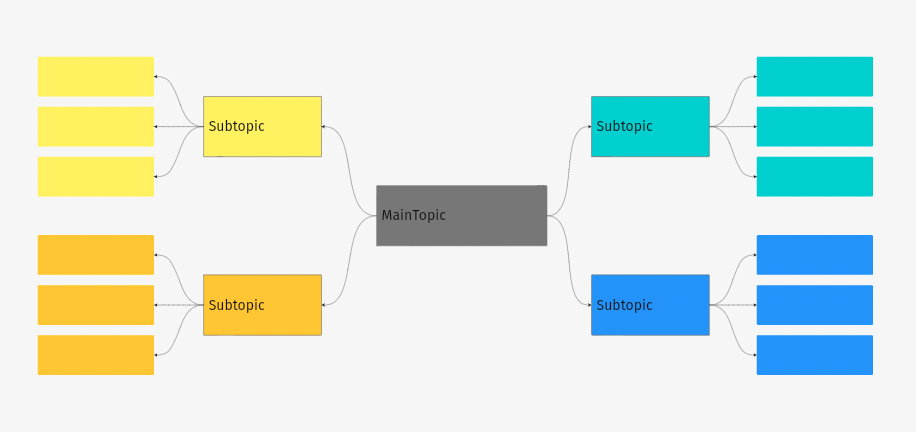When was the last time your team had a group brainstorming session? You probably daydream a couple of times each day, but how often do you set aside time to generate new ideas? In a society where we’re always looking to check things off our to-do list, it can feel silly to spend time exploring new concepts.
However, creating space for ideation can help you increase innovation, solve more problems, and establish a sense of camaraderie. Brainstorming sessions work best with established ground rules and a bit of planning. That way, you can ensure your team walks away with fresh ideas to develop and explore.
In this article, we’ll highlight some of the top benefits of brainstorming, guidelines for success, creative techniques you can use in any work environment, and the Vibe products that can help you along the way.
What is Brainstorming?
Brainstorming is the process of group discussion to produce ideas or solve problems. Brainstorming is an incredibly helpful tool that can help teams to find new solutions that had not been previously considered. A brainstorming session is an opportunity to examine a problem from every angle and think creatively. There are no bad ideas in a brainstorm.
The pros of brainstorming as a group
If brainstorming as a group requires planning and logistics, why do it? There are dozens of benefits to be had for teams that carefully organize their brainstorming sessions. We’ve gathered some of the highlights to inspire you as you integrate brainstorming into your meetings, workshops, and planning sessions.
New perspectives
Ever felt like you were too close to an issue to make any further progress? It’s not uncommon to experience tunnel vision, especially when you’ve been working on a project for a while. Brainstorming sessions can open you up to new points of view. As you bring others into the topic at hand, they can take a look at it from a holistic perspective. Doing so will help to expand that tunnel vision into a more comprehensive picture.
A change of pace
These days, many of us are bogged down with meetings, deliverable creation, and dealing with work about work. Brainstorming is a fantastic way to shake things up. Everyone gets a chance to take a break from doing and can focus instead on creating. Gather your colleagues for a quick session (using the ideas below) and watch the ideas flow.
Related: Ask These Icebreaker Questions at Your Next Virtual Meeting
Ideas for future projects and deliverables
The ideas you generate in a brainstorming session don’t have to be limited to the topic at hand. Save the list of ideas to reference in the future. The concept of idea building is a popular benefit to brainstorming. Idea building is all about sharing new ideas which inspire participants to generate more ideas. Remember: each idea shared in the session doesn’t have to serve an individual solution. They can also be edited, modified, or even combined to create a solution.
Camaraderie
Want to increase collaboration and teamwork? Brainstorming sessions can help with that. After all, everyone has to work together to generate new ideas. Plus, asking for help shows vulnerability and helps to establish trust. To best encourage a sense of camaraderie, ask participants to avoid criticism. Remind everyone of the purpose of brainstorming: idea-collection. The more you can focus on generating ideas instead of curating them, the better results you’ll have.
As you continue to practice brainstorming, your team will feel more comfortable sharing ideas with each other. You can even use the session to help drive consensus on a plan of action.
{{< blog/cta-1 “Make meetings matter with the Vibe Smart Whiteboard” “https://vibe.us/lp/scenario-meeting” >}}
Why is Brainstorming Important in Business?
A team’s ability to brainstorm is a key element to success. A team without open brainstorming discussions may find that ideas and solutions come only from the top down. In reality, good ideas come from anywhere and everywhere. Part of a manager’s job to seek out ideas from their direct reports, consider those ideas against their own as objectively as possible, and decide the right direction to take.

Guidelines for group brainstorming
To generate the best results from your brainstorming sessions, start by laying the ground rules. You can adapt them to your own company culture or departmental goals as needed. That being said, the following guidelines are applicable to every brainstorming session:
- Give ideas freely.
- Withhold criticism (of your own ideas or anyone else’s).
- Allow everyone to contribute and participate.
- Don’t be afraid of out-of-the-box or unusual ideas.
- Focus on generating ideas instead of solutions.
Remind your team there are no dumb ideas, except for the one you didn’t share. Brainstorming should be a fun, light-hearted, and open experience. Yes, some of these ideas will hopefully end up being implemented in the future. However, it’s important to keep things positive. If participants feel like their ideas will be scrutinized, they’ll be less willing to share.
So, welcome even the most outlandish, “How in the world would we do that?” ideas. Model idea building for your team. Emphasize quantity; you can even set a target number of ideas to generate by the end of the session.
While planning your next brainstorming event, be sure to consider the following:
- Who will serve as the facilitator for the session
- Ways to model techniques
- How to record ideas and where
- Materials and technology needed
- Timing: how long to devote to explanation, generation of ideas, and wrap up
- Desired result: what you hope to walk away from the session having accomplished

Brainstorming techniques for all workplaces
Brainstorming doesn’t have to be an onsite-only event! The following techniques work well in any workplace setting.
Brainwriting
Brainwriting is a fun technique that functions in all work settings. During brainwriting, participants jot down several ideas on post-it notes. These notes are recorded anonymously to avoid any bias or concern over sharing ideas.
These ideas are then placed on a surface for everyone to see. The facilitator selects ideas at random. The team then shares feedback regarding each idea. The facilitator can also categorize each idea and then review them with the group by category.
Brainwriting is especially beneficial for teams new to brainstorming. It’s also a good technique to try when you’re tight on time. By keeping ideation and discussion separate, you can avoid the conversation going off-course.
Rapid ideation
Ready to work in a flash? Try rapid ideation. This technique is similar to brainwriting in that everyone writes down as many ideas as possible in a given time period. You’ll need a timer to keep track of the time remaining. If you’re working remotely, try using breakout rooms with a countdown to create a sense of urgency.
If you’re having trouble getting participants to focus on idea generation, give rapid ideation a spin. This technique prevents any quelling of ideas before the team even has a chance to hear them. With the time constraint, participants will be more likely to generate an idea and move onto the next one.
Related: How to Prepare for Your First Whiteboarding Session
Round-robin
The round-robin brainstorming technique is a simple way to encourage full participation from your team. The nice thing about this method is that it doesn’t require several materials or a complicated setup. To get started, have the facilitator share an idea. Emphasize the importance of sharing an idea alone, not critiquing it. Then, move on to the next participant until everyone has shared one idea. As you move from participant to participant, keep things focused on ideation. During this stage, there is no discussion or reflection. You may want to give your team a few minutes to think of their ideas.
Round-robin brainstorming will set your team up to generate ideas quickly and avoid any off-topic discussion.

Stepladder
The stepladder technique begins with the facilitator sharing a question or issue with the entire group. Then, two team members remain in the room while the rest leave. (Here’s where Zoom breakout rooms come in handy!) The remaining duo shares their ideas together, which can be captured on a piece of paper or smartboard. Once the time is up, the facilitator allows another team member into the session.
The newcomer shares their idea first with the duo. The duo then shares their ideas with the newcomer. Once time is up, the facilitator lets in another team member. This fourth participant shares their idea. The process continues until everyone shares an idea and all group members are back in the session.
The stepladder technique is effective for avoiding groupthink and building rapport amongst team members.
Starbursting
Brainstorming sessions aren’t just limited to the beginning phase of a project. You can use the starbursting technique to flesh out an idea your team has already selected. To get started, refresh your team on the idea. Write it on a whiteboard (ideally one that’s interactive!) and draw a star with six points around it. Label each point as who, what, when, where, why, and how.
Then, expand who, what, when, where, why, and how into actual questions. For example, for “who,” you could ask, “Who is this idea or product for?” For “when,” you could try, “When will this product or plan go live?” The starbursting technique helps participants focus on generating answers to the questions. The team can work together to find solutions and further define the idea.
The 5 Whys
The 5 Whys is a popular technique for digging down to the root of a problem. To give it a spin, identify a specific problem. Have the facilitator ask, “Why is this problem occurring?” Allow the team to generate possible reasons. Once you’ve identified a starting answer, ask why again. Repeat the process at least five times to find the root of the issue. This technique is a good way to reexamine common challenges as a group.

To take your brainstorming sessions to the next level, don’t forget to include your Vibe Board. These interactive whiteboards are purpose-built for collaborating, ideation, and brainstorming. To get a closer look at Vibe, watch our demo video.
FAQs
What are the four rules of brainstorming?
The five rules of brainstorming are simple:
- Every idea matters.
- No idea left behind.
- Embrace new brainstorming techniques.
- Innovate and iterate on your brainstorming process.
Can brainstorming be done alone?
While brainstorming is typically done in a group, brainstorming on your own is an important skill to have. The ability to brainstorm solo demonstrates that you are able to look at a problem from many different perspectives to find the right solution. There are helpful tools like mind maps or other diagrams that can help you on your solo brainstorming journey.
Is there a best brainstorming technique?
The best brainstorming technique is the one that works best for you and your team. Try out a few of the ideas listed in this article and see how your results shift throughout the various brainstorming methods.
